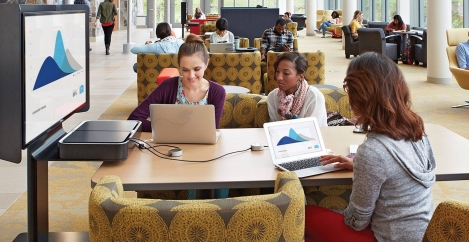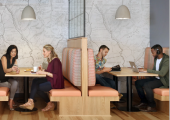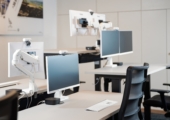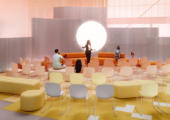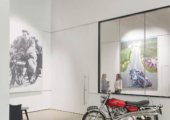September 19, 2018
The main challenge of modern working life: finding the place just right to meet 0
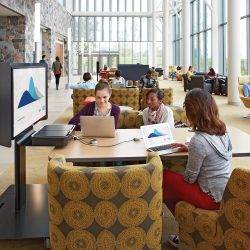 Every physical setting sends distinct signals to meeting participants – signals that set the tone and provide a context for the conversation, even when they are subtle or not in anyone’s conscious awareness. You understand instinctively that the place where a meeting occurs has an impact on the nature of the conversation. Just imagine the difference between a conversation around a large formal conference table with expensive executive chairs and one that takes place in an informal employee lounge, with the participants seated in a circle on soft bean-bag chairs. Or consider the classic image of a boss seated behind a large desk, in front of a large window framing her silhouette as she delivers a performance review to a “lowly” subordinate sitting across the desk in a low, hard-back chair. Now think about that same performance review being conducted on two softer wing chairs of equal height, with a low coffee table between them. Or in a nearby restaurant or coffee shop. Or on a trail in the woods adjacent to the corporate office. Which of those conversations do you think will evolve in a more caring, respectful, and supportive mode?
Every physical setting sends distinct signals to meeting participants – signals that set the tone and provide a context for the conversation, even when they are subtle or not in anyone’s conscious awareness. You understand instinctively that the place where a meeting occurs has an impact on the nature of the conversation. Just imagine the difference between a conversation around a large formal conference table with expensive executive chairs and one that takes place in an informal employee lounge, with the participants seated in a circle on soft bean-bag chairs. Or consider the classic image of a boss seated behind a large desk, in front of a large window framing her silhouette as she delivers a performance review to a “lowly” subordinate sitting across the desk in a low, hard-back chair. Now think about that same performance review being conducted on two softer wing chairs of equal height, with a low coffee table between them. Or in a nearby restaurant or coffee shop. Or on a trail in the woods adjacent to the corporate office. Which of those conversations do you think will evolve in a more caring, respectful, and supportive mode?
Place matters. However, having choices about place matters even more. While many of us who are knowledge workers move around frequently from one workplace to another, finding “the place just right” for getting a particular task done is often difficult. Sometimes we need a quiet place and sometimes we want to engage with colleagues informally, while at other times we attend meetings with either focused group decision-making or open-ended brainstorming agendas. Each of those activities works best in a different physical setting.
Okay, that makes sense. But how does the design of the workspace affect your mood, your creativity, your ability to concentrate? More importantly, how does place impact the nature and tone of your conversations? And how does a change of place change a conversation?
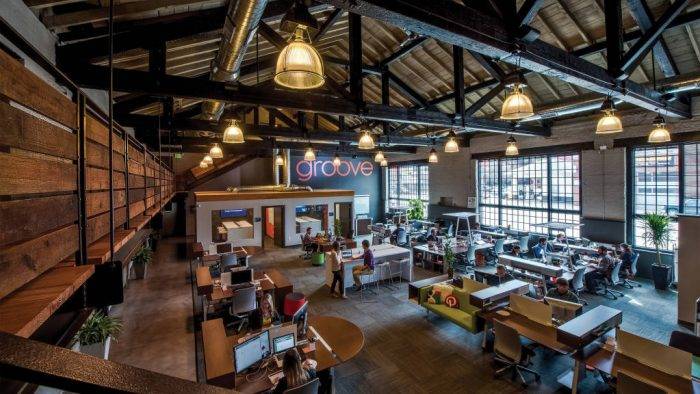 Change the Place, Change the Conversation
Change the Place, Change the Conversation
Several years ago one of my business friends inherited a staff of civil servants who were “retired on the job.” They were disengaged, bored, putting in their time, and not particularly focused on performing. Gloria Young was at that time the Clerk of the Board of Supervisors of the City and County of San Francisco. That meant she was essentially the Chief of Staff for the Board; all the city employees supporting the Board reported to her.
Young developed a multi-faceted strategy for addressing her staff’s malaise. She prepared formal, written job descriptions that included performance goals and metrics which she did collaboratively with the individual job holders, so the descriptions, goals, and metrics reflected their knowledge of their own responsibilities as well as hers.
Young also developed a “shadowing” activity that quickly became a cross-training and succession-planning program. Selected individual employees would spend a day or so a week actively observing, following, and “shadowing” one of their colleagues at work. This process not only helped the “shadower” learn a new job, but at the same time it helped the “shadowee” understand his or her job more completely.
Often during the shadowing process the shadower would stop the shadowee to ask a question like, “Why did you just do that?” or “Why are you filing that document in that drawer?” Those conversations not only helped the shadower understand what was happening, but they usually forced the shadowee to reflect on the work task, and the ensuing conversation often led either to deeper understanding of what needed to be done, or to a conscious redesign of the work.
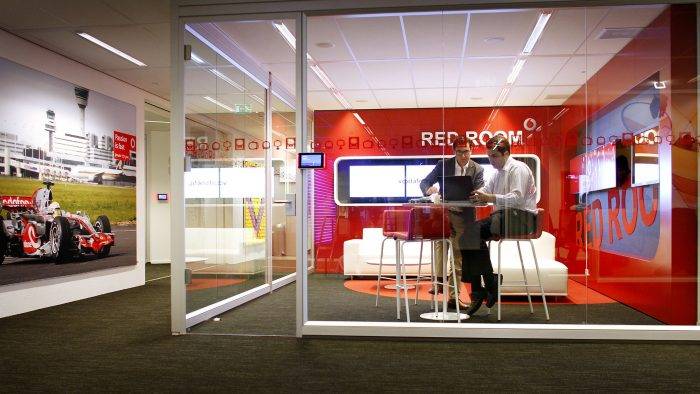 These new conversations created a revolution within Young’s team. Her staff learned to think much more actively about their own work as well as what their colleagues were doing. Details about work flows, procedures, and skill requirements were out in the open – there for all to see, to comment on, and to learn from. But the most significant change that Young introduced – one that quite literally transformed the nature of the conversations in her department – was her purchase of a dozen inexpensive canvas folding chairs.
These new conversations created a revolution within Young’s team. Her staff learned to think much more actively about their own work as well as what their colleagues were doing. Details about work flows, procedures, and skill requirements were out in the open – there for all to see, to comment on, and to learn from. But the most significant change that Young introduced – one that quite literally transformed the nature of the conversations in her department – was her purchase of a dozen inexpensive canvas folding chairs.
Why folding chairs? It had become obvious to Young that her team was mired in a set of routine habits that were relatively unproductive. Staff meetings were often uninteresting, low-energy, and full of issue avoidance. No one was engaged; the meetings felt like a waste of time, especially to her.
The staff meetings had traditionally taken place in the department conference room, which was a classic design: a big wooden table surrounded by uncomfortable chairs in a small, drab room with almost no natural light. There was a white board at one end of the room, and a projector for sharing presentation slides when needed. The side wall had a large but bland painting hanging over a credenza that could hold a pot of coffee and plastic cups, along with some extra pads of paper and a few nondescript ballpoint pens.
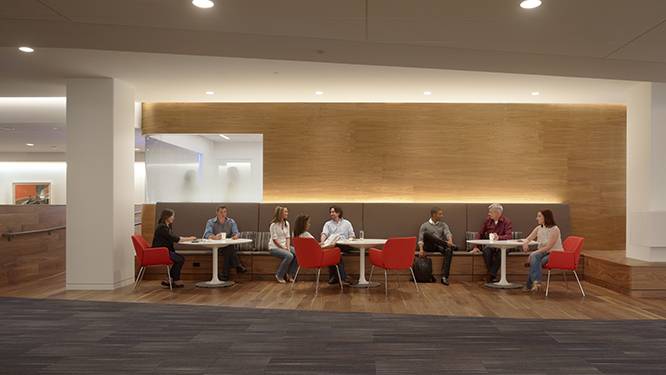 That set of blue canvas chairs led to a dramatic shift in the nature of the group’s conversations. When Young wanted to engage her staff in a brainstorming meeting, or one requiring a tough decision, she would tell everyone “It’s time for a blue chair meeting.” Each staff member would pick up a chair and the group would troop down to the building lobby, or outside onto the plaza (or somewhere else nearby) if the weather was nice.
That set of blue canvas chairs led to a dramatic shift in the nature of the group’s conversations. When Young wanted to engage her staff in a brainstorming meeting, or one requiring a tough decision, she would tell everyone “It’s time for a blue chair meeting.” Each staff member would pick up a chair and the group would troop down to the building lobby, or outside onto the plaza (or somewhere else nearby) if the weather was nice.
The team would set up the chairs in a circle, sit down, and start talking to each other as if their ideas mattered (which of course they did). As Young told me, “The change in the setting, in combination with the informal chairs, created a completely new atmosphere that stimulated all kinds of creative conversation.”
Apply this insight to your own experience. How different are the conversations that fill your conference rooms from the ones that take place in the employee lounge, in the company cafeteria, around the proverbial water cooler, or in a nearby restaurant over lunch or with an after-work adult beverage?
Place matters
Traditional conference rooms send all kind of signals about what kind of conversations are appropriate. That conference room I described earlier has a “head end” where the team leader usually sits – the position of power. And the formality of the table and chairs and white board or flip chart tells everyone what the meeting will be like and how it will unfold.
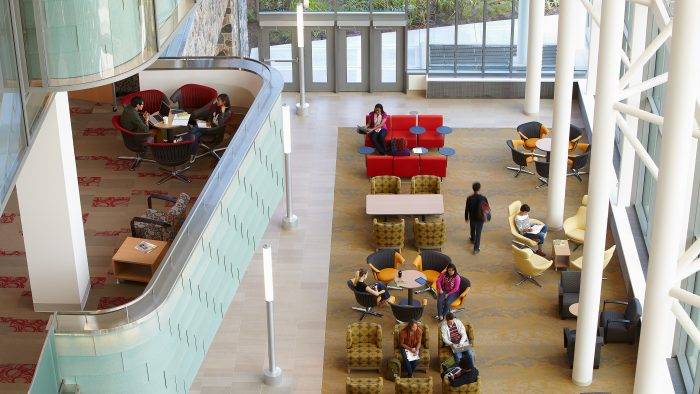 A few years ago SCAN Health Plan, based in Long Beach, California, undertook a major office renovation that was designed both to save space and money, but also to support a corporate initiative to break down silos and encourage much more active collaboration across teams.
A few years ago SCAN Health Plan, based in Long Beach, California, undertook a major office renovation that was designed both to save space and money, but also to support a corporate initiative to break down silos and encourage much more active collaboration across teams.
Among the new design features were a set of what Diane Coles-Levine, the director of workplace solutions at SCAN at the time, called “collaboration parks.” There is now one area on each floor that includes a glass-enclosed conference space filled with soft chairs, low tables, moveable writing tables, and lots of light and bright colors. No large, heavy conference tables!
And outside each of those “conversation pits” is an open area that typically includes three or four small, lightweight tables suitable for small group meetings. Each table has electrical and Ethernet ports built in, and a speaker phone to enable remote staff to participate easily in those meetings.
Finally, just beyond the open table area on each floor is a coffee bar accompanied by several small elevated tables that enable still more informal conversations. Coles-Levine is convinced that those collaboration parks had a significant positive impact on the culture at SCAN Health, which in turn contributed to a measurable uptick in the organization’s productivity and employee satisfaction.
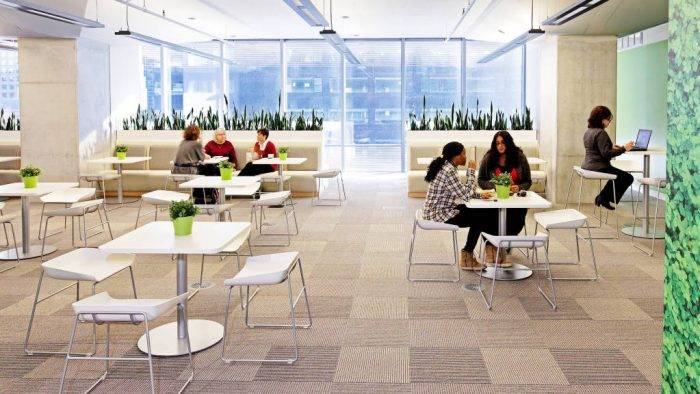 I once consulted with a high-tech medical services company where the CEO believed fervently in the value of having the entire workforce in the corporate office every day. She was so convinced that face-to-face collaboration was critical that she actively discouraged her staff from working at home or other remote locations. In fact, because gasoline prices were almost $5 a gallon at that time, she was seriously considering subsidizing the cost of commuting from employees’ homes to the corporate office to ensure that everyone came to the office every day.
I once consulted with a high-tech medical services company where the CEO believed fervently in the value of having the entire workforce in the corporate office every day. She was so convinced that face-to-face collaboration was critical that she actively discouraged her staff from working at home or other remote locations. In fact, because gasoline prices were almost $5 a gallon at that time, she was seriously considering subsidizing the cost of commuting from employees’ homes to the corporate office to ensure that everyone came to the office every day.
However, in spite of her well-known opinions about working remotely, when we walked through the office on one occasion we couldn’t help but notice how many cubicles and conference rooms were vacant; we estimated that over half of the workstations in the building were empty that day.
Not only that, but later that afternoon several of us accidentally discovered that one of the company’s most important product design teams was holding a one-week planning meeting at a nearby (but offsite) co-working facility. Our own team met at that same facility late one afternoon to debrief our work with the CEO, which is how we discovered the offsite product design team.
The product design team leader had opted to spend company money renting an open, informal conference room at the offsite location because he and his team wanted to get away from the stodgy (and relatively unused) corporate conference rooms and the inevitable interruptions to their intense conversations that would have occurred had they stayed onsite.They changed their place to change their conversation. And it worked.
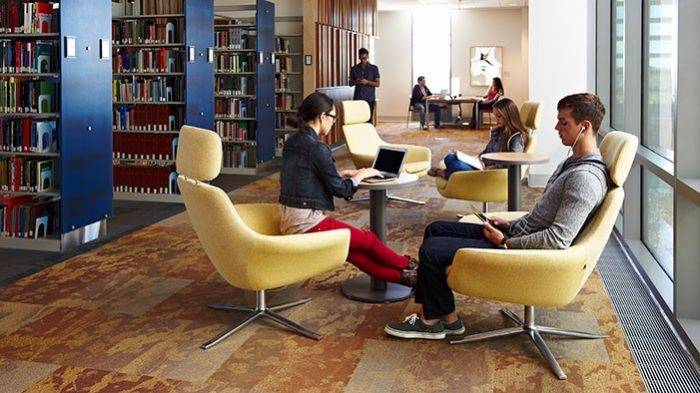 Can’t think straight? Take a hike!
Can’t think straight? Take a hike!
And sometimes it pays to get out of a place altogether. Here are a few more examples. Diane Coles-Levine, who left SCAN Health in 2014 and is now the head of independent consulting firm, is fond of saying, “It’s a lot easier to think outside the box when you’re not in one.” That’s her way of pointing out that cube farms are not the best environment for creativity and collaboration.
And as I have observed several times, when individuals make choices about where and when to get their work done they “own” those choices and are generally more committed to their work, more productive, and more engaged with their employers. About five years ago I was part of an international research project team that was seeking to define the attributes of an effective workplace. Our Swedish lead researcher asked each of us on the project team to take a photograph of our favorite part of our own office and then to post it on the project website.
What do you think those photos showed? Almost three quarters of us took a picture of the view outside the nearest window! We all valued our views of nature. My picture from my home office was of our backyard garden, and the view beyond of San Francisco Bay.
There is also solid evidence that hospital patients whose beds are next to a window with a natural view typically recover more quickly than those whose beds do not have views of nature. Roger Ulrich, the author of “View Through a Window May Influence Recovery from Surgery” (Science, 1984), described his research this way: Twenty-three surgical patients assigned to rooms with windows looking out on a natural scene had shorter postoperative hospital stays, received fewer negative evaluative comments in nurses’ notes, and took fewer potent analgesics than 23 matched patients in similar rooms with windows facing a brick wall.
There’s something about nature that we all find soothing, refreshing, and inspiring. Getting out of the box that is your office can have a powerful impact on your productivity, your emotional frame of mind, and even your sense of self-worth.
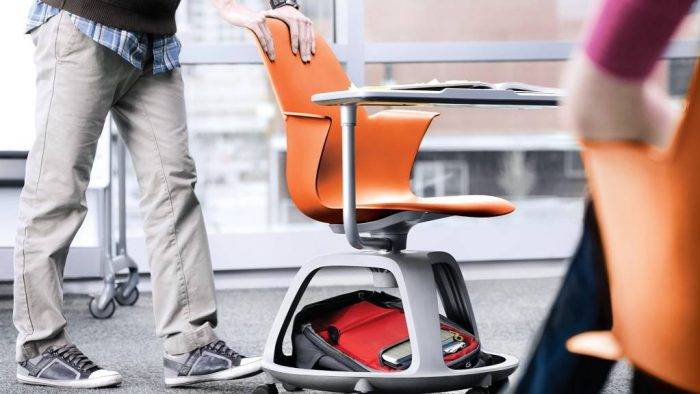 So when you are feeling stressed, or stuck, take a break; get up, get out of the office, and take a walk. Tony Schwartz and Christine Porath, in their May 2014 New York Times article “Why You Hate Work,” tell a story about Luke Kissim, the CEO of Albemarle, a multi-billion dollar chemical company. Kissim realized he was personally burning out on the job, so he began taking a break at least every 90 minutes, and he often left the building to take a walk around the block.
So when you are feeling stressed, or stuck, take a break; get up, get out of the office, and take a walk. Tony Schwartz and Christine Porath, in their May 2014 New York Times article “Why You Hate Work,” tell a story about Luke Kissim, the CEO of Albemarle, a multi-billion dollar chemical company. Kissim realized he was personally burning out on the job, so he began taking a break at least every 90 minutes, and he often left the building to take a walk around the block.
Kissim then began insisting that all his employees follow suit. He’s put over 1,000 of Albemarle’s managers through a course that’s teaching them how to invest in themselves and in their staff – and a big part of that investment is getting up and taking walks – outside the building.
Finally, another wonderful example of the value of getting back to nature is what’s happened at Western Union’s corporate headquarters in Englewood, Colorado. The company recently redesigned its facilities and landscaped the surrounding grounds to include walking/hiking trails through the woods.
I was fortunate to hear John Coons, Western Union’s Vice President of Corporate Real Estate (since retired), talk about how many of the company’s managers and staff are now taking regular outside walks (weather permitting, of course); and, more importantly, many of them have started holding critical one-on-one performance review conversations with their staff out on the trail.
Just think about how much more meaningful those conversations must be than if they were held in an enclosed office with a big desk separating the manager from his/her subordinate. As I have said so often, place matters. To change the conversation, change the place – and be sure to include Mother Nature in your definition of “place.”
Pick the place to fit your purpose
So the next time you want a creative, high-energy meeting filled with open, authentic conversation, find a place that says “Talk openly, we’re all in this together, let’s have fun and get something done.” What does that kind of place look and feel like? When I want to encourage open, candid, and high-energy conversations, I look for physical settings that include:
plenty of natural light;
bright but not overpowering colors;
simple artwork;
moveable tables and chairs (so the group can reconfigure the arrangement and take ownership of it);
white boards and/or flip charts for note-taking; and
simple refreshments (including fresh fruit and nuts, but not sugar-based products!).
And if you can’t do a wholesale office renovation to create those kinds of spaces, at least think about getting your own set of blue canvas chairs, or getting outside and away from the office. As Gloria Young discovered with her blue chair meetings, a change of place can be refreshing and re-engaging even if you don’t go off to a spa or a beach-side resort. Even though a group meeting may be your best choice for addressing a particular issue, remember that you don’t have to hold a traditional meeting in a traditional place (by that I mean one where you reserve a conference room, set a time, and convene the group around a conference table).
If your purpose is simply to make an announcement, or to provide a quick status report (perhaps you do that every Monday morning), consider a brief stand-up meeting in your office, or in a common area. That simple shift in both the place and the process can create an entirely different experience for the participants, and usually produces a different outcome as well.
_______________________________________________
 James Ware, PhD is a Global Research Director for Occupiers Journal Ltd. He is also the founder and Executive Director of The Future of Work…unlimited, and a Partner with The FutureWork Forum. Jim was a co-author and the lead editor for Cut It Out! Save for Today, Build for Tomorrow, published by the IFMA Foundation in 2009. He also authored the chapter on change management for the recently-completed book Work on the Move: Driving Strategy and Change in Workplaces, also from the IFMA Foundation (October 2011). He holds a PhD, M.A., and B.Sc. degrees from Cornell University and an MBA (With Distinction) from the Harvard Business School.
James Ware, PhD is a Global Research Director for Occupiers Journal Ltd. He is also the founder and Executive Director of The Future of Work…unlimited, and a Partner with The FutureWork Forum. Jim was a co-author and the lead editor for Cut It Out! Save for Today, Build for Tomorrow, published by the IFMA Foundation in 2009. He also authored the chapter on change management for the recently-completed book Work on the Move: Driving Strategy and Change in Workplaces, also from the IFMA Foundation (October 2011). He holds a PhD, M.A., and B.Sc. degrees from Cornell University and an MBA (With Distinction) from the Harvard Business School.
This article is adapted from Chapter Six of Making Meetings Matter: How Smart Leaders Orchestrate Powerful Conversations in the Digital Age. (Indie Books Int’l, 2016). It was originally published in the Work&Place.
Note:
The phrase “the place just right” comes from a traditional Quaker song titled “Simple Gifts.” The song includes these lines:
“’Tis the gift to be simple, ‘tis the gift to be free;
‘Tis the gift to come down to where we ought to be;
And when we find ourselves in the place just right,
‘Twill be in the valley of love and delight.”
I find that phrasing both haunting and compelling, and it is such an apt description of the feeling we get when a meeting or conversation goes well that I enjoy using it in the context of meetings and meeting rooms.





